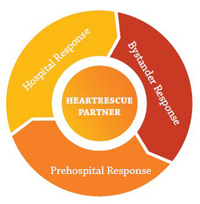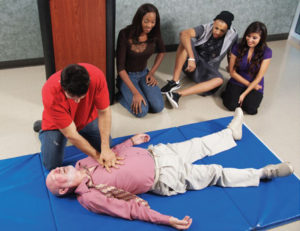The Medtronic Foundation is pleased to provide you with this planning guide to assist your efforts to increase sudden cardiac arrest (SCA) survival rates within your community.
This guide was compiled by experts in resuscitation science and reviewed by HeartRescue Project Partners. It includes current information on many of the individual actions upon which SCA survival depends as well as valuable resources and references.
It is designed to provide a comprehensive, yet practical, step-by-step approach to improving SCA survival at each of three distinct levels of response and care.
About HeartRescue
 The HeartRescue Project is an unprecedented, collaborative effort to increase sudden cardiac arrest (SCA) survival rates in the United States, improving how SCA is recognized, treated and measured.
The HeartRescue Project is an unprecedented, collaborative effort to increase sudden cardiac arrest (SCA) survival rates in the United States, improving how SCA is recognized, treated and measured.
Funded by the Medtronic Foundation and working with the country’s leading emergency and resuscitation experts, the project is focused on systemically developing and expanding SCA community response systems.
The approach relies on the delivery of best practices at three critical levels of response: prompt action from bystanders, rapid response and quality care delivered by emergency medical services and first responders, and a coordinated approach to the provision of specialized post-arrest care in the hospital.
The vision is for every American who suffers SCA to receive lifesaving, state-of-the-art care at the scene, en route, and in the hospital.
SCA Facts
Sudden cardiac arrest is a public health crisis, striking an estimated 295,000 Americans each year. (Circulation,2012;125:e2)
- Nationally, 89% of those who suffer SCA die before reaching the hospital — a rate that hasn’t changed significantly over several decades. (Circulation,2012;125:e2)
- SCA kills six times more Americans each year than breast cancer. And more than AIDS, lung, breast and prostate cancer combined.
- Your chances of survival fluctuate by as much as 500 percent, depending on where you live in the country. (JAMA,2008;300:1423)
SCA is a treatable disease. Improving survival rates requires measurement and a coordinated community response.
- Data collection standards currently exist to capture incidence and outcomes. Only through measurement can we make informed decisions and replicate best practices.
- Improving survival rates requires a collective community response by the general public, first responders, EMS services and in-hospital caregivers.
- Success begins with public bystanders. Communities with higher bystander CPR participation have higher SCA survival rates.
- Eighty percent of SCA events occur in the home.
- Everyone should recognize SCA and know how to call 911, start chest compressions and how to find and use an AED.
About the Author
Lynn White, HeartRescue Project Education Director, National Director of Resuscitation and Accountable Care, American Medical Response, Greenwood Village, CO
The HeartRescue Partners
University of Arizona Sarver Heart Center, Arizona Department of Health Services
Arizona has a unique SCA reporting and education network called SHARE (Save Hearts in Arizona Research and Education), which includes the majority of Arizona residents. The SHARE network implements effective new SCA approaches statewide. On the research side, the University of Arizona Sarver Heart Center has developed a national reputation for its leadership in chest compression-only CPR. Strong partnerships between government agencies, hospitals, and research groups provide this organization with a solid backing.
The University of Minnesota, Cardiovascular Division
The University of Minnesota Medical School-Cardiovascular Division leads the Minnesota Resuscitation Consortium, a statewide partnership of organizations and acute care physicians focused on providing a new platform of treatments and technologies to more rapidly deploy and evaluate advances in the treatment of sudden cardiac arrest.
Duke University, Wake County EMS, North Carolina Office of EMS
In North Carolina, the RACE CARS program (Regional Approach to Cardiovascular Emergencies Cardiac Arrest Resuscitation System) makes up the largest statewide system of emergency cardiovascular care, coordinating 119 hospitals and 540 EMS agencies to rapidly diagnose and provide emergency treatment for heart attacks and sudden cardiac arrest. Part of this strategy includes community education and reducing disparities in SCA treatment.
University of Pennsylvania Center for Resuscitation Science
The University of Pennsylvania is world renowned for its research and training in therapeutic hypothermia: the cooling of SCA patients to minimize brain and organ damage. Furthermore, Pennsylvania is tackling sudden cardiac arrest deaths through a statewide collaborative effort to increase SCA survival rates and patient outcomes through prompt bystander intervention and EMS response, and to improve data collection and implementation of best practices during post-arrest and in-hospital care.
University of Washington, Cascade HeartRescue Program
Seattle and surrounding King County both report one of the highest sudden cardiac arrest survival rates in the world thanks to longstanding work by dedicated emergency medical services (EMS) providers and physicians in Washington state. Education has played a key role in this success. More than 70 percent of the Seattle area population is trained in CPR. The Cascade HeartRescue program is an ongoing collaboration of the Harborview Paramedic Training Program, the Medic One Program of Seattle Fire Department, King County Emergency Medical Services and the University of Washington-Harborview Center for Prehospital Emergency Care whose goal is to improve cardiac resuscitation care and outcome throughout Washington state.
American Medical Response
AMR is the single largest provider of EMS in the United States, covering almost 48 million people in 2,000 communities in 39 states. The 17,000 AMR paramedics and EMTs provide care to 25,000 SCA victims each year. As a partner in the HeartRescue Project, AMR has the potential to influence and partner with citizens, dispatch centers, first responders, public health agencies and hospitals across the country.
The Illinois HeartRescue Collaborative
The Illinois HeartRescue Collaborative is a partnership between the University of Illinois Hospital and Health Service System, the Chicago Fire Department, Chicago EMS System and the Illinois Department of Public Health. They will work to develop a statewide network for cardiac arrest reporting and quality improvement. They will promote cultural competency strategies that encourage, expand and support community-initiated grassroots efforts aimed at improving SCA survival rates.
How to Cite This Publication
Cite this article as: Every Second Counts. Every Action Matters. A Community Response Planning Guide for Sudden Cardiac Arrest. The Medtronic Foundation HeartRescue Project, Minneapolis, MN. Vol. 3: 2012.


